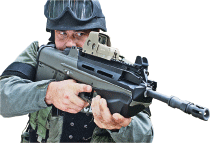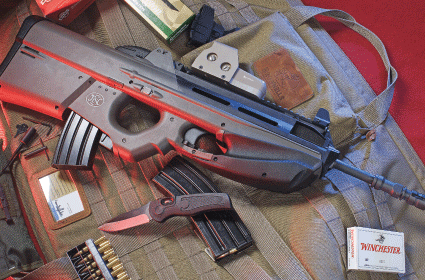FNH’s FS2000 had been one of the most anticipated semi-auto battle-rifles. Now that it has been available to shooters for more than a year, most would agree that the wait was worthwhile, since the FS2000 gives shooters a chance to own one of the world’s highest-tech rifles. Other bullpup battle rifles or carbines have overcome much of the original skepticism, thus setting the stage for the FS2000 to gain wide acceptance on the US market. Just as a sidenote: The only military contract that I know of for the military version, the F2000, has been from Slovenia.
 I will admit that I like bullpup battle rifles and have done a lot of shooting with them. As a result, I’ve learned to appreciate their advantages and compensate for their disadvantages.
I will admit that I like bullpup battle rifles and have done a lot of shooting with them. As a result, I’ve learned to appreciate their advantages and compensate for their disadvantages.
Let’s talk advantages first: Bullpup rifles offer a full power rifle in a package that’s closer in size to an SMG than a typical battle rifle. As a result, bullpups are very handy for use in confined spaces. They can be handled with one hand while opening doors or performing other tasks. Despite their short overall length, bullpup rifles have standard length barrels, which give good ballistic performance. Although bullpup carbines appear to be somewhat ungainly, most are very ergonomically designed and quite comfortable to shoot.
Advertisement — Continue Reading Below
However, unless a bullpup has a very well designed sling, they can be very ungainly to carry for extended periods. Certain features of some bullpups have to be studied. For example, the standard version of the FAMAS positions the cocking handle under a carrying handle/sight rail, which makes it very difficult to get leverage to clear a stuck case; the SA80 and AUG do not lend themselves well to shooting off of the support side shoulder, and so on.
One reason I’m such a fan of the F2000 and FS2000 is that they have the good points of other bullpup carbines without the negatives. Oh, it does need a good sling for extended carry, but other than that, the design is very good.
Gun Details
As I write this, FNH has recently introduced the FS2000 Standard, which incorporates the sight module supplied on military F2000 carbines. The model I have been using for this article is the FS2000 Tactical with a Picatinny rail. Most comments will apply to either carbine. Overall length is only 29.13 inches, yet barrel length is 17.38 inches. Caliber is 5.56x45mm (.223) with a barrel twist of 1-in-7 inches, indicating that 62-grain SS108 ammunition would be best here. Weight of the Tactical Model is 7.6 pounds (empty). Either a 10-shot or 30-shot round magazine is supplied, depending on the laws in the state where the FS2000 is shipped. The Tactical Model has a set of backup iron sights that are rudimentary but relatively effective to 100 meters.
Advertisement — Continue Reading Below
The FS2000 employs a gas-operated, closed rotary bolt design. The molded polymer construction is tough and ergonomic. At first I thought the butt was too large, but now that I’ve gotten used to it, I like it. The thumbhole stock is very comfortable and fully ambidextrous. For use in cold weather while wearing gloves, the molded triggerguard is large. The FS2000’s hammer-forged barrel has an integral muzzle brake and is finished in black anodized for low reflectivity and durability.
What really sets the FS2000 above most other contemporary battle rifles is the ergonomics, especially for use within vehicles or in other confined spaces. The folding left side charging handle can be easily operated without losing the sight picture while in prone position. Both the magazine release and safety dial can be operated ambidextrously. A note on the magazine well and release: Because of the depth of the magazine well it’s necessary to thrust a magazine home very smartly to ensure it seats. It is also necessary, when doing a magazine change, to pull it from the magazine well smartly. A very positive aspect of the deep magazine well is that the magazine does not protrude as much as on a typical carbine and hence, has less chance of snagging when moving through undergrowth, kicking a door, or leaving or entering a vehicle.
An FS2000 feature I am especially fond of is the forward ejection system, which throws cases forward and down. The design is that even when you’re prone, cases will be fully ejected. This system allows use of low cover without having hot cases ejected into or onto one’s face. It also allows the FS2000 to be used within a vehicle without throwing hot brass around. In fact, if the forearm is thrust outside of the vehicle, brass will be ejected down and outside the vehicle.
Advertisement — Continue Reading Below
Speaking of the forearm, it is another very well designed feature of the FS2000. It offers a very comfortable grip for the support hand. Its shape allows it to be used with a variety of rests to steady the carbine. I have used packs, grassy mounds, rails, and assorted other rests quite effectively with the FS2000.
Check out a review of the FNH FS2000 5.56mm here!
ELCAN SpecterDR
Since I do use the Tactical Model, I started out experimenting with different optical sights. Although I tried various ones that worked quite well, I have decided that ELCAN’s SpecterDR grants the FS2000 the most versatility. The SpecterDR was developed to address a tactical situation, which has arisen during the War on Terror. Operators can find themselves engaging terrorists in a CQB situation such as building clearing, then almost immediately transitioning to countersniper mode because they are taking fire from rooftops or somewhere else at a distance. To address this situation, ELCAN developed the SpecterDR that incorporates a lens system, which by the flick of a lever can be switched from 1x to 4x almost instantly. Because a unit I advise is considering adopting the SpecterDR, I was fortunate to obtain one of the military contract versions. When I was looking for a carbine to mount on it, I thought the FS2000 would be an excellent choice to test it out.
Advertisement — Continue Reading Below
The “DR” in the SpecterDR’s designation stands for Dual Role. When using the SpecterDR on 1x in CQB mode, one can use the optic as an illuminated red dot with black crosshairs. In this mode, the field of view is quite wide (146.3 feet at 100 yards). At 4x, the field of view at 100 yards is still 34.2 feet. The crosshair reticle allows precise shooting at 100 meters and incorporates stadia lines for 200 to 600 meters. The entire reticle can be illuminated in five brightness settings of red for low light shooting, or just the red dot may be illuminated in five brightness settings for CQB usage. In either mode, the SpecterDR is night vision compatible. The stadia lines may also be used for range finding. Adjustments are in ½-MOA increments, which I find precise enough for a battle rifle optic.
Since ELCAN optics are used by military units worldwide, they are designed to be very sturdy and to hold up to battle conditions. This includes high shock resistance to dropping or jarring, as well as being waterproof to 66 feet for at least 2 hours. The throw-lever mount is also designed to military specs and will hold up to being taken on or off the carbine a couple hundred times. There is also an ARD (Anti-Reflection Device) available for the SpecterDR. I have not had a chance to try the optic with an ARD mounted.
Range Time
I’ve been using my FS2000 with the SpecterDR for a few months now and like the combo. In fact, I find that when on my way to the range to test other rifles I’ll often throw the FS2000 in my truck and fire a couple of magazines through it as well. For me, the FS2000/SpecterDR combo works great from 25 meters or less, and out to 300 meters. The compact FS2000 handles quickly for CQB-type shooting on multiple targets at close range, where the wide field of view allows very quick target acquisition as one scans an area. I also find that at ranges from 100 to 300 meters, I do just as well on the 4x setting. With SS109 ammo I have shot sub-MOA 3-shot groups at 100 yards with the best around 0.75 of an inch. I have not broken an MOA at 200 or 300 yards, though I did have quite a few groups under 2.5 inches at 200 yards.
Advertisement — Continue Reading Below
I do quite a bit of shooting with the FS2000 off my support side (left) shoulder and have gotten used to closing my right eye so that I can use my left eye with the SpecterDR. I also shoot with it prone quite a bit and find it very comfortable. I’ve used the SpecterDR when I’ve done some vehicle counter-ambush training, since it lends itself well to use within the vehicle and from cover behind the wheelwells. It performed quite well.
Final Notes
I initially wanted to try the FS2000 because I had shot the military F2000 in Belgium some time ago and wanted to see how well it could be designed as a semi-auto. I think the semi turned out exceedingly well. FNH offers a truly different semi-auto battle rifle for those of us who like “black rifles” (though the FS2000 is available in green as well).
The SpecterDR is a specialized optic, which is quite pricey so I doubt most who own an FS2000 will put it on their carbine. It is, though, a very innovative and versatile optic, which helps the special operator transition between CQB and countersniper much more readily.
Advertisement — Continue Reading Below
I like the FS2000 and the SpecterDR a lot and highly recommend the FS2000 for tactical use as well as for enjoyment among sport shooters who like military-type rifles. I also recommend the SpecterDR to military or law enforcement personnel who may need its particular type of combat diversity.























